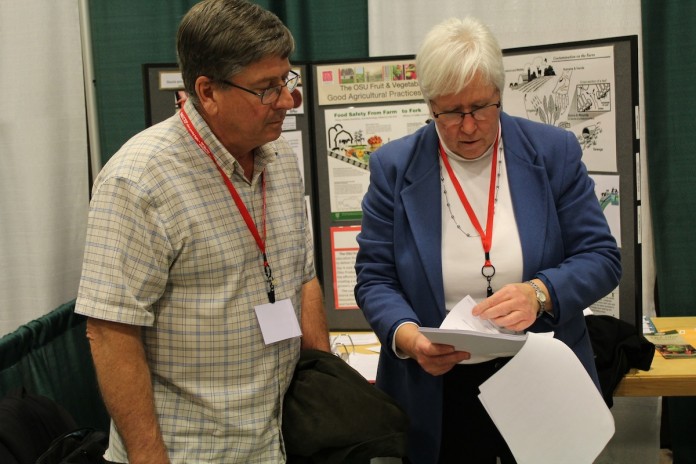
DALTON, Ohio — The new produce safety rules that farmers and the produce industry have been talking about for years will finally go into effect Jan. 26.
And even though some producers will be exempt, and others will generally have at least two years to comply, the rules are already a priority issue for growers. The rules were one of the main topics at this year’s Mid-Ohio Growers Meeting in Dalton, Jan. 14-15.
The Food and Drug Administration announced the final rule in November. It sets “science-based minimum standards” for the safe growing, harvesting, packing and holding of fruits and vegetables grown for human consumption.
The main tenants of the new rule pertain to water quality and testing, adding amendments to soil, sprouts, domestic and wild animals, worker training, and the maintenance of equipment, tools and buildings.
“The Food Safety and Modernization Act is touching virtually every part of our food system here in the United States,” said Emily Adams, OSU Extension educator from Coshocton County.
Exemptions apply
Farmers who produce less than $25,000 a year in produce crops will be exempt, according to FDA. And the rule does not apply to produce that is cooked, or not consumed raw.
Very small businesses (those with more than $25,000 but no more than $250,000 in average annual produce sales) will have four years to comply.
Small businesses (those with more than $250,000 but no more than $500,000 in average annual produce sales ) will have three years, and all other farms will have two years to comply.
“They (FDA) understand, from a compliance standpoint, that it takes time,” said Adams. “How much time you get depends on how big you are.”
Local enforcement
Terri Gerhardt, chief of food safety at the Ohio Department of Agriculture, said, like farmers, she is still studying the new rule and everything that’s included.
Gerhardt said ODA plans to adopt and enforce the new produce safety rules in compliance with FDA, and that ODA “will be your primary point of contact.”
She said the compliance time gives farmers and inspectors time to educate themselves about what’s at stake, and prepare for the new rules.
“This is new for everybody,” Gerhardt said, adding that ODA plans to work with OSU Extension, to help educate farmers in advance.
She reminded producers, however, that they still need to be following the Good Agricultural Practices of growing and handling produce, even before their compliance dates kick in.
Farm animals
Of particular concern to farmers at the Mid-Ohio meeting, most who were Amish, is the rule’s treatment of farm animals and wildlife. The rule treats grazing and work animals the same as wildlife.
It states that “Farmers are required to take all measures reasonably necessary to identify and not harvest produce that is likely to be contaminated.”
But it also states that “farms are not required to exclude animals from outdoor growing areas, destroy animal habitat, or clear borders around growing or drainage areas.”
Gerhardt said FDA lists the goal, but gives farmers some flexibility to decide how they accomplish the goal.
The main thing, she said, is using common sense, and keeping manure and contaminants away from food products.
Clean water
Another topic for farmers is ensuring the water they use — whether during the growth of the plant, or after harvest — is tested and free of contaminants.
Adams said producers need to take a minimum of 20 water samples, over a two- to four-year period, to establish a baseline analysis. These initial samples will tell producers if there is a problem, and what they need to do to bring their water into compliance.
Lindsey Hoover, OSU’s food safety program coordinator, said the presence of generic E. coli does not necessarily mean the water is contaminated.
However, the higher amount of generic E. coli that your test results show, “the greater chance that you have a pathogenic E. coli.”
Water used for post-harvest activities, or direct contact with edible produce must have no detectable generic E. coli, and water used during the growing process must fall within the acceptable levels of generic E. coli, established by FDA.
Related:
- FDA finalizes produce safety rules, Nov. 17, 2015.









